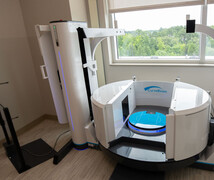A hairline fracture, also known as a stress fracture, is a small crack in a bone. They most often appear in the legs or feet and are usually caused by a change in activity level that results in increased repetitive stress on the bone. “The typical story is that somebody started long-distance running, or went back to football after summer break, or changed their running shoes so that their arch is supported differently,” says Duke orthopedic surgeon Robert T. Tisherman, MD. We sat down with Dr. Tisherman to learn more about hairline fractures.
What does a hairline fracture feel like?
It’s almost always in just one spot. Typically, people with a hairline fracture won’t have pain until they’re walking or running on it. The pain will appear during exercise; for example, they can run two miles with no problem but as soon as they get to two and a half miles, they experience pain. The amount of time they can run without pain decreases as the fracture worsens.
Are hairline fractures serious?
It depends on where the fracture occurs. If it’s in the shin bone, that’s the most concerning to us since that bone is truly weightbearing, and if you break through it, it’s really serious and requires surgery. Hairline fractures in other bones hurt, but they’re not likely to cause the bone to break completely.
When should you seek treatment for a hairline fracture?
If you’re feeling a lot of pain in just one spot anytime you walk a certain distance, then it’s time to get an X-ray from your primary care physician or an orthopedic surgeon. Stress fractures may not show up on an X-ray, so if we have reason to suspect one and we’re not seeing it on an X-ray, we’ll order an CT scan or an MRI to confirm.
How are hairline fractures treated?
The typical way we manage hairline fractures is by taking the weight off of them, usually with crutches, with or without a boot, depending on where the fracture is. We’ll have you on crutches generally for anywhere from two to six weeks to let the bone heal, though sometimes it can take three to four months to completely resolve.
If the person really can’t take time off, for example, if they are a professional athlete, or if the fracture just isn’t healing, we may perform surgery or use other therapies such as medications which can stimulate bone healing or external ultrasound devices that help to speed up the healing. We’ll also recommend vitamin D and calcium to support bone health and promote healing.
Why choose Duke for hairline fracture care?
We treat a lot of athletes, so we see hairline fractures all the time. If our patients need surgery, we have sports, trauma, and foot and ankle surgeons who help them get back to their activities faster. If they don’t need surgery, we know how often to follow up with CT scans, and we know who’s going to need bone stimulators or other medical management. We’re used to an active population and our multi-disciplinary team of physicians, physical therapists, nutritionists, and primary care physicians are experienced in handling these fractures.





